
About Oaks (home) | Map | Plant List | Cultivar/Species Information | Sources | Other Campus Oaks of Interest
Latin Name: Quercus robur
Common Name: English Oak
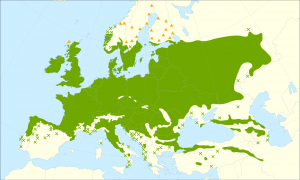
Caudullo, G., Welk, E., San-Miguel-Ayanz, J., 2017.
Chorological maps for the main European woody species. (https://commons.wikimedia.org/wiki/File:Quercus_robur_range.svg)
Cultivar:
Family: Fagaceae
Division: White
Range: British Isles, s. Scandinavia, most of continental Europe
Introduced:
Sun/Shade: sun
Height: 40' - 60' × same under U.S. landscape conditions
Form: broadly rounded
Zones: 5 - 8
Flower: Male flowers in drooping catkin clusters; female flowers single or in pairs, inconspicuous.
Leaves: 2" - 5", 3+ pairs of rounded lobes, glabrous dark green above, paler beneath; petiole very short.
Fall Color: not good
Fruit: Acorn. Long and narrow, about 1", cap covers up to 1/3; ripens to a shiny brown.
Buds: rounded, plump, at an angle; chestnut to reddish brown
Bark: grayish-black, deep furrows
Wildlife: Birds, small mammals, deer. For a wonderful look at all the organisms Quercus robur supports, from mammals and birds, to invertebrates, to fungi, lichens, and mosses, see The Woodland Trust's "Oak Trees and Wildlife" ("2,300 species supported by oak, 326 species depend on oak for survival, 229 species rarely found on trees other than oak") and the incredibly detailed and beautifully illustrated The Natural History of the Oak Tree: An Intricate Visual Exploration of the Oak and Its Environment by Richard Lewington and David Streeter (available used or through your local library).
Disease issues: Powdery mildew can sometimes be an issue.
Cultural Uses: Timber, especially for ship-building; the foundation of the British Royal Navy. Listen to "Heart of Oak," the official march of the Royal Navy of the United Kingdom.
Folklore: Much has been written about the English Oak's Druidic importance in the British Isles, and its role in the spiritual and mundane life of other pre-Christian European cultures.
Where to find Quercus robur in Maxwell Arboretum: 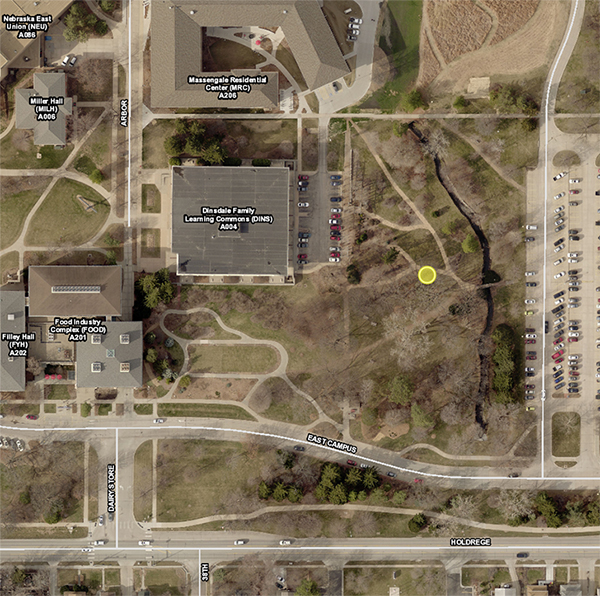
NOTES:
Learn more here from the English Oak experts at the Woodland Trust.
EVERY QUERCUS TELLS A STORY, DON’T IT: THE RESOLUTE DESK and QUERCUS ROBER (ENGLISH OAK)

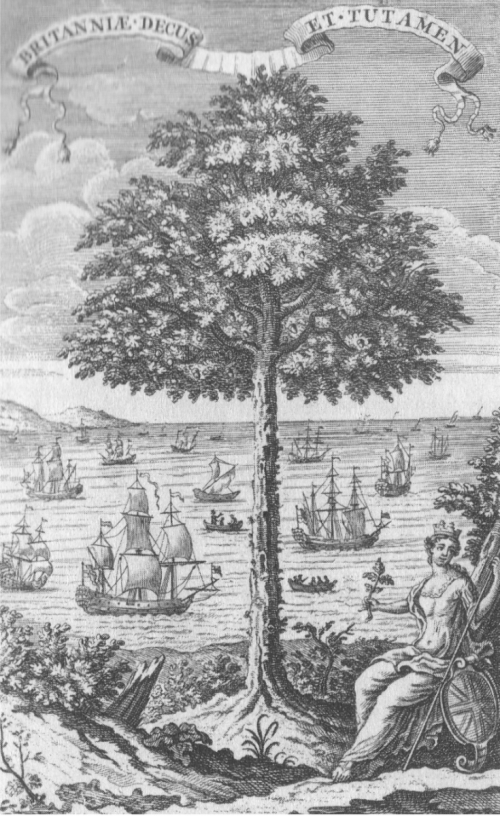
“The artist of this eighteenth-century illustration has placed a tree in the center. to emphasize its crucial role in the well being of British society. Over the tree a Latin inscription reads ‘Britain’s Glory and Protection.’ This statement rang true since from timber ships like those depicted in the background were built the battleships and oceangoing vessels which served as the means for England’s supremacy as a military and trading power. Britania (right foreground), who symbolized Great Britain, holds a[n oak] seedling, the key to England’s future.” (William Andrews Clark Memorial Library, University of California, Los Angeles)
From: A Forest Journey: The Story of Wood and Civilization. John Perlin, Woodstock, VT: Countryman Press|W.W. Norton & Company, 2005.
In 1845, Sir John Franklin led two ships, the HMS Erebus and the HMS Terror in search of the Northwest Passage in the Canadian Arctic. Both ships became icebound near King William Island and while most of the original 129 men survived that first year, in April of 1848, after Franklin and two dozen of the crew had perished, the ships were abandoned. Over 100 men set out across the ice for mainland Canada and were never seen alive again. . . .

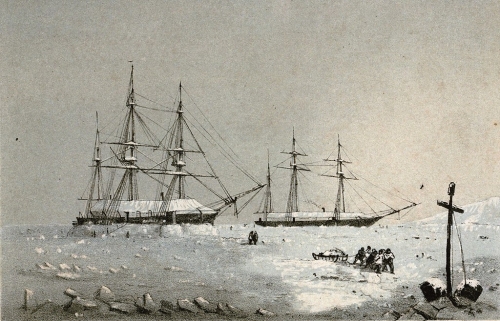
“H.M.S Resolute and H.M.S. Intrepid, winter quarters, Melville Island, 1852-53
When George Frederick McDougall drew the picture after which this print was made,
he was a Master on H.M.S. Resolute. Colored lithograph, 5 x 7 5/8 in.” National Maritime Museum, Greenwich, London.
[under edit revision]

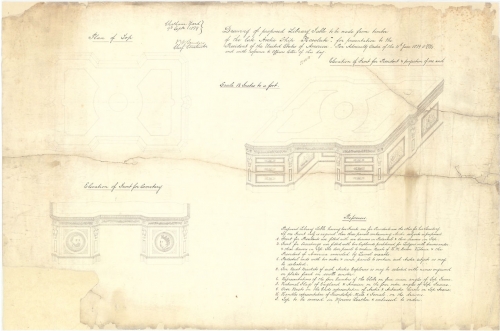
“Plan showing the front elevation, top and projection of the proposed President’s Desk to be made from the timbers of HMS Resolute (1850), an exploration ship. The ship had been abandoned in the Canadian archipelago, only to be recovered by a US whaler after they found it had broken free and was drifting. The US Government refitted the ship and sent it back to England as a goodwill gesture.” National Maritime Museum, Greenwich, London
A few modification were made to the desk over the years, including the installation of a panel over the kneehole to hide the leg braces of FDR. When President Kennedy installed a secret taping system in the Oval Office, a microphone and off/on switch were place in the desk.

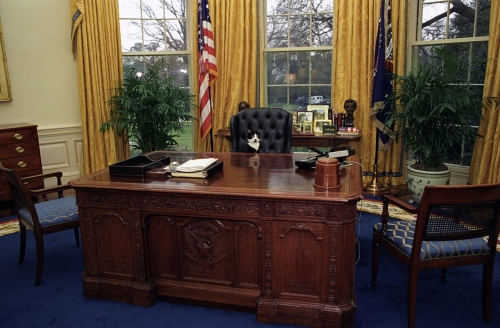
Socks at the Resolute Desk. 1994. (The Clinton family cat.)
_______
TEXT OF THE PLAQUE ON THE RESOLUTE DESK:
←Previous Oak → NEXT OAK
All images from Maxwell Arboretum unless otherwise noted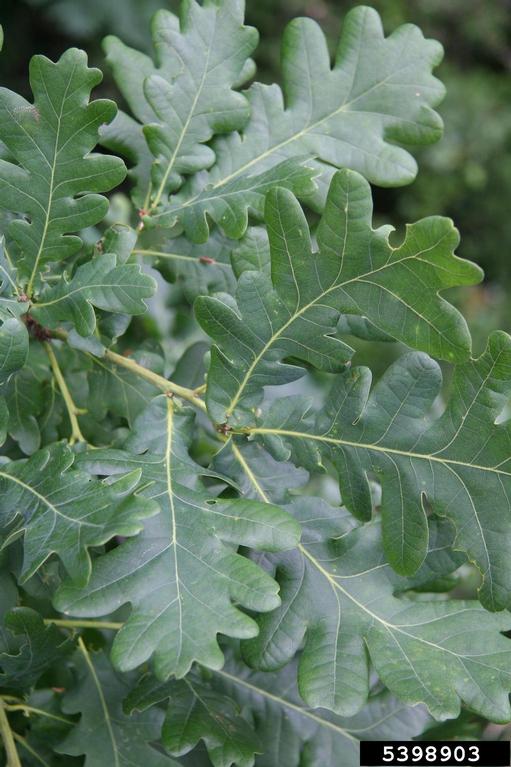
Foliage
Robert Vidéki, Doronicum Kft., Bugwood.org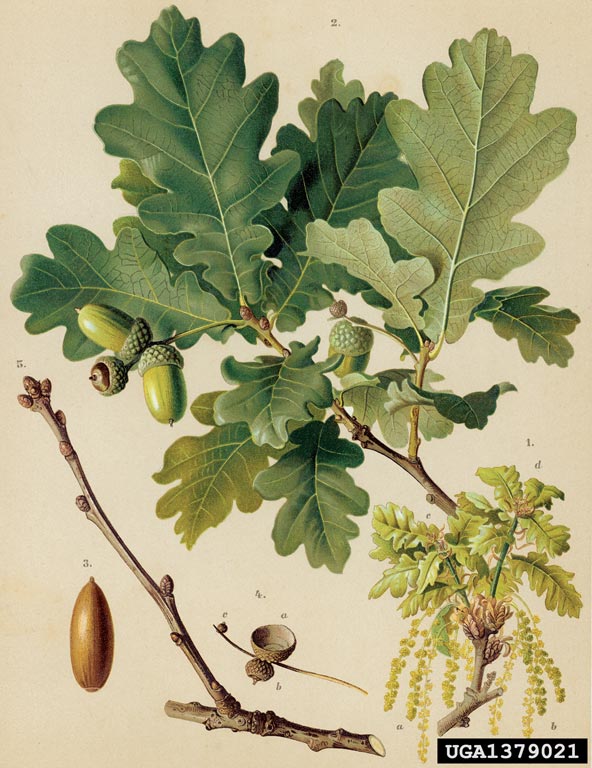
Zelimir Borzan, University of Zagreb, Bugwood.org
1. Branchlet with young shoots, male (a, b) and female (c, d) inflorescences. Typically several female flowers develop with each long, slender peduncles. - 2. Branchlet with mature shoots and almost ripe fruits (acorns). - 3. Ripe acorn, at the end of the first season. - 4. Peduncle with empty cup (a) and aborted fruits (b, c). - 5. Winter-branchlet; buds are egg-shaped, roundish at the top. After Hempel & Wilhelm, 1889. Photos and explanations from the book: Zelimir Borzan. "Tree and Shrub Names in Latin, Croatian, English, and German, with synonyms", University of Zagreb, 2001.
Acorn
UNL East Campus